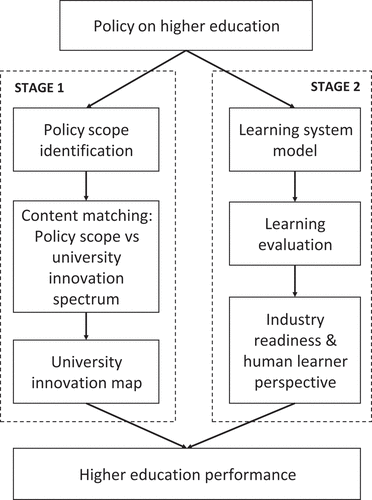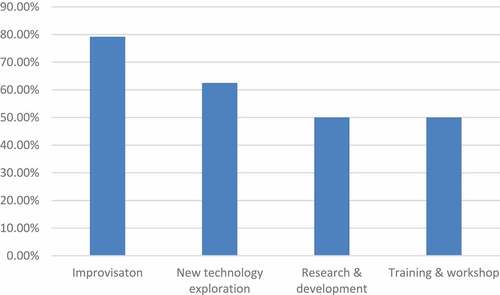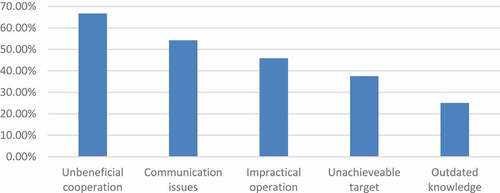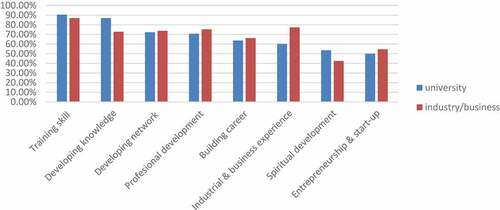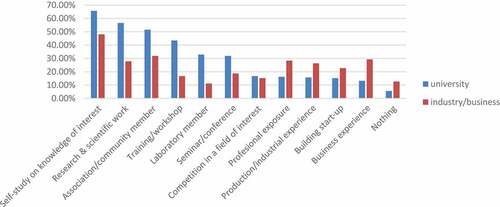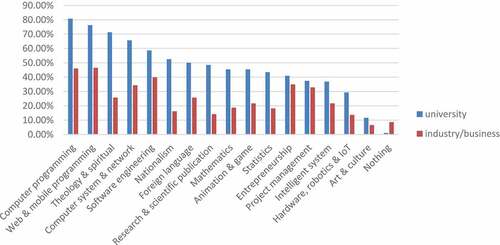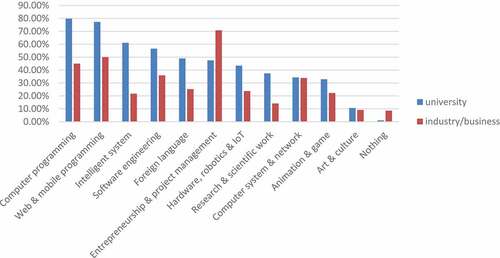 ?Mathematical formulae have been encoded as MathML and are displayed in this HTML version using MathJax in order to improve their display. Uncheck the box to turn MathJax off. This feature requires Javascript. Click on a formula to zoom.
?Mathematical formulae have been encoded as MathML and are displayed in this HTML version using MathJax in order to improve their display. Uncheck the box to turn MathJax off. This feature requires Javascript. Click on a formula to zoom.Abstract
This study discusses the role of university and industry in Indonesia’s higher education system, particularly in learning information technology and the related fields. Three data sources were used to collect information on learning practices, i.e., the higher education policies representing the government’s perspective, the knowledge capitalization practices representing the industry readiness to act as a joint provider of knowledge and skill with the university, and the perspectives of human learner as the subject of learning processes. The study proposes two-stage evaluation on higher education practices that consists of policy analysis and the evaluation of learning practices based on the model of learning system. The former is to map the higher education policy to the spectrum of university entrepreneurial activities, while the latter is the survey on learning practices participated by the industry, students, and alumni. Policy analysis identifies the blank spot on the activities of consulting, spin-off firm formation, and the creation of a technology park. The evaluation of learning practices shows that the university still becomes the dominant actors in the transfer of knowledge and skill, except for the fields of entrepreneurship and project management which the industry excels. These results indicate that university contributes primarily in growing the internal capacity of human resource, while the industry contribute in shaping the professional life. This study suggests that the practice of higher education in Indonesia requires a more aggressive strategy in triple helix relations to enable the achievement of knowledge society and knowledge economy by strengthening the whole spectrum of university entrepreneurial activities.
1. Introduction
Common problem in higher education is the gap between graduate qualification versus the industrial or business needs. This problem usually exists in developing countries due to the lack of university curriculum to catch-up with the industrial or business practices. We argue that this problem hampers university role in national innovation system and disturbs the achievement of knowledge society and economy. Started from this point, the term “industry” is used to refer to both the industry and business organization.
Nowadays, Indonesia has launched a program to strengthen the collaboration between the university and the external stakeholders by issuing a national standard for higher education, namely “the freedom to learn, the independent campus” or “Merdeka Belajar Kampus Merdeka” (MBKM) as its original term in Indonesia’s language (Pabbajah et al., Citation2020; Sartika, Citation2020). The program offers eight optional ways for every university student to establish the learning process that consist of industrial internship, the rural project, the student exchange, the research project, the entrepreneurship, the certified independent study, the humanitarian project, and teaching at school. A strategic approach to establish the linkage between the university and the industry is enabled by the implementation of industrial internship and the certified independent study. Hence the government at the national level launches a top-down approach to host the internship activities and the certified studies that are organized by the ministry of education and culture. Many high-profile companies and some state-owned enterprises from the field of information technology participate in the program, and therefore enable the open of many internship vacancies for the student of information technology and the related fields such as in computer science, information system, and computer engineering. Moreover, a bottom-up initiative to develop MBKM for the local scope has been carried out through the collaboration between the university and the association of start-up and software house in several cities, in which a web-based platform hosting the offers of internship from many local start-ups and software houses becomes the implementation of the program. Many local students join with the program as well. It seems the program to distribute university students to the industry has been successful both in national or local scope. The program enables a long-term collaboration between the university and the industry that is driven by the student’s demand to have an industrial experience.
Meanwhile, Indonesia’s national standard on higher education (SNPT, Citation2020) regulates the main business core of every university that consist of the education, research, and society services. It states that every university shall fulfil the minimal criteria of learning process, research, and society service in higher education that covers the content, process, output, evaluation, actors, supporting facilities, management, and funding support. The implementation of the standard is evaluated by the national accreditation board in regular basis, usually every 5 years. The aspects to be accredited are the organization vision and strategies, the management and collaboration, student activities, human resources, funding and facilities, learning practices, research, society service, and the output of enforcing education, research and society service. Here, the research becomes the source of knowledge for learning process, while society service becomes a direct media for knowledge transfer to the society. The government also organizes the annual competitive research program at national scope to support the funding of research and society service in university (DGHE, Citation2015).
On the other hand, triple helix relations of university, industry, and government (Etzkowitz & Leydesdorff, Citation1998, Citation2000) state that the university innovation open the path to achieve knowledge society and knowledge economy. The optimistic approach emphasizes the economic contribution of university innovation that is generated by the university entrepreneurial activities (Bercovitz & Feldman, Citation2006; Petruzzelli, Citation2011). Here, we follow Etzkowitz et al. (Citation2000) and Philpott et al. (Citation2011) that define university entrepreneurial activities as university’s efforts to improve regional or national economic performance and its financial advantage. In this case, Philpott et al. (Citation2011) identify a spectrum of university entrepreneurial activities that ranges from the traditional to entrepreneurial paradigm which consists of producing highly qualified graduates, publishing academic results, grantsmanship, consulting, industry training courses, contract research, patenting and licensing, spin-off firm formation, and the creation of a technology park. Abramo et al. (Citation2009) show that university-industry collaborations in Italy deliver better academic research performance compared to the research based only on a single organization. Petruzzelli (Citation2011) shows that successful university-industry collaborations in Europe are affected by the technological relatedness, prior ties, and the quality and reputation of university. Motohashi and Muramatsu (Citation2012) show how university-industry collaborations in Japan deliver more valuable patents to represent technology advancement rather than registered by only a single organization. Wallin et al. (Citation2014) develop a strategy to reduce the gap between university and industry that consists of strategic understanding, tactical co-creation, and operational ideation. A more pessimistic approach on university-industry collaborations has been growing in many developing countries. In this case, the university tends to develop the learning innovations to follow or imitate industrial practices due to the concern of graduate’s quality. Al-Shehri et al. (Citation2013) show the university effort in Saudi Arabia to periodically organize the industrial trainings in collaboration with oil companies. Buth et al. (Citation2017) develop the learning factory to shape the university graduate with the industrial experience in India. Vaaland and Ishengoma (Citation2016) state that the reluctance of the internal university members to collaborate with the industry in developing country becomes the major cause that hampers university-industry linkages, despite the lack of resources and innovative capabilities that contribute to the ineffective and inefficient national innovation system.
The above condition raises a concern on the policy enforcement in Indonesia’s higher education. Does the policy guide the higher education to the correct direction? And to what extent the higher education policy have been supporting university innovation particularly in the field of information technology? The study aims to evaluate the effectiveness of Indonesia’s higher education policies to drive university innovation in information technology learning and the related fields. The study also intends to discuss the program’s impact to the national innovation system by disclosing the position of each higher education policy from the perspective of university entrepreneurial activities. The hypothesis employed in this study is that the higher education policy is capable to strengthen the university entrepreneurial activities by empowering higher education with the industrial knowledge and research capacity. We also intend to measure to which extend the policy is capable to drive the role of university and industry as the agent of knowledge and skill in higher education.
2. Conceptual model
2.1. University entrepreneurial activities
Etzkowitz and Leydesdorff (Citation2000) state that the role of university in economic development through the innovation of knowledge and research becomes the third mission of university beside the main activities in research and teaching. The enforcement of this mission must be supported by the regulation and strategy to organize the market pull and technology push for knowledge transfer from university to industry. In this case, Etzkowitz et al. (Citation2000) define university activities to improve the economic development at local or national scope and to gain a financial advantage as the university entrepreneurial activities. The model developed from this perspective views entrepreneurship as a set of activities to contribute to economic development which contains the interaction between the following processes, i.e., the university innovation in knowledge and research, the knowledge transfers and acquisition in university-industry interaction, and the economic contribution by university as shown by Figure . The model shows that the economic development is directly driven by the university innovation in research and knowledge. Many researchers follow this model such as Petruzzelli (Citation2011), Motohashi and Muramatsu (Citation2012), and Wallin et al. (Citation2014) by proposing various strategies for university-industry interaction. Moreover, Petruzzelli (Citation2011) even states that the university-industry interaction shall be organised at policy level to achieve an optimum economic development.
Furthermore, Philpott et al. (Citation2011) introduce the spectrum of university entrepreneurial activities that spans from the soft initiatives which is closely related to the traditional practice of university in research and teaching, to the hard initiatives exhibiting more entrepreneurial paradigm. Indeed, various university innovation originated from research and teaching influence the economic development either in local, national, regional, or even global scope. However, various studies disclose that the hard initiative from many universities contribute minor for knowledge transfer (Agrawal & Henderson, Citation2002; Bubela & Caulfield, Citation2010; Philpott et al., Citation2011; Povoa & Rapini, Citation2010). Hence, it is not surprising that many efforts particularly from the developing countries take a softer approach to achieve entrepreneurial activities by strengthening the curriculum with the industrial practice in order to improve student qualification (Al-Shehri et al., Citation2013; Buth et al., Citation2017). This approach views entrepreneurship as the ability to innovate and adapt to the industry, therefore it must be delivered to the student in a teaching process. It is worth to note that the economic contribution of the university is driven by the alumni activities in industrial sector. Thus, the university indirectly contributes to economic development as shown by the model in Figure .
Here, we assume that both direct and indirect university contributions to economic development have been organised at policy level. In this case, it is set up by MBKM (Pabbajah et al., Citation2020; Sartika, Citation2020), the national standard on higher education (SNPT, Citation2020), and the national competitive research program (DGHE, Citation2015). Although the idea of MBKM is a bit different from other implementation of soft initiative, in which it employs a more liberal strategy to improve student competence by sending the students directly to the industry based on student preference rather than enhancing the curriculum with industrial content, however the atmosphere to improve graduate competence is apparently presented in this approach. Hence, the conceptual model developed in this study is the hybrid approach that accommodate both hard and soft initiative of university contribution to economic development as shown by Figure . The hybrid model enables the evaluation of higher education policy, industry support, and human learner experience to drive university entrepreneurial activities.
2.2. Information technology learning
The term information technology learning refers to the undergraduate education based on Computing Curricula 2020 (ACM-IEEE, Citation2020). The standard defines a set of computing disciplines namely computer engineering, computer science, cybersecurity, information systems, information technology, software engineering, and data science that compose six knowledge categories, i.e., users and organizations, systems modelling, systems architecture and infrastructure, software development, software fundamentals, and hardware; and 34 knowledge areas, i.e., social issues and professional practice, security policy and management, information system management and leadership, enterprise architecture, project management, user experience design, security issues and principles, systems analysis and design, requirements analysis and specifications, data and information management, virtual systems and services, intelligent systems, internet of things, parallel and distributed computing, computer networks, embedded systems, integrated systems technology, platform technologies, security technology and implementation, software quality verification and validation, software process, software modelling and analysis, software design, platform-based development, graphics and visualization, operating systems, data structures algorithms and complexity, programming languages, programming fundamentals, computing systems fundamentals, architecture and organization, digital design circuits and electronics, and signal processing. In this research, these knowledge areas are grouped into their categories and combined with the content of national curriculum (SNPT, Citation2020) that contains the knowledge of religion, nationalism, entrepreneurship, and art & culture, to become the basis of questionnaire development.
3. Materials and methods
3.1. Methodology
The research is to study the impact of enforcing higher education policy to university innovation in information technology learning. It comprises two evaluation stages that consists of policy analysis and learning evaluation based on learning system modelling as shown by research design in Figure , in which the higher education policies become the basis of evaluation. Here, the policy analysis is to disclose the support of higher education to university innovation as shown by Stage 1, while the evaluation of each component composing the learning system as well as the experience of human learners is conducted by Stage 2. The elaboration of each stage is given as follows.
The first stage (Stage 1) is the policy analysis that aims to identify the role of higher education policies to drive university innovation. It is a content analysis to explore the scope of activities that are organized by each policy on higher education. This approach discloses the capacity of each policy to enable the university entrepreneurial activities, and to reveal the role of each policy to drive university innovation. The analysis is started by selecting the policies that organize the standard on higher education practices, and then is continued by identifying the scope of higher education activities to be covered by each policy. Content matching is then employed to develop a correspondence matrix to map the content of each policy document on various activities of university innovations based on their similarities. Here, the analysis utilizes the spectrum of university entrepreneurial activities from Philpott et al. (Citation2011) to identify university innovation.
Second stage (Stage 2) is the learning evaluation based on system modelling that aims to disclose the feasibility and the impact of enforcing a higher education policy in a learning environment. It is necessary to model the learning system by drawing the behaviour of each entity contained in the system due to the influence of MBKM in higher education. The initial condition before MBKM is depicted by the solid line that shows three-stage of interaction in Figure . This model consists of three actors, i.e. the human resource, the university, and the industry. The first actor is the human resource that grow from the learners who need to study at the university, to become the professionals that fulfil the industrial needs. The second actor is the university that becomes the agent of knowledge and skill due to the main activities in research and training, and perhaps with a less amount of activities in the production and business. The third actor is the industry that become the agent of employment and career. In this case, the third actor is assumed to have more activities in the production and business rather than in research and training even though they may deal with all of these activities.
Figure 5. The solid-lines depict the initial condition before MBKM, while the dashed-lines are the added activities due to MBKM.
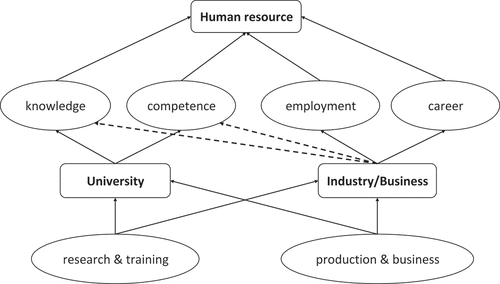
After MBKM, the condition is slightly changed as shown by the dashed lines in Figure that present the new assignment for the industry as the agent of knowledge and skill. It seems that the government has been questioning the usability and the compliance of technology transfer from university to the industry through human resource development. Therefore, the government needs to upgrade the human resource by increasing the role of industrial practice in education system. It is conducted by driving the participation of industry to supply the knowledge and skill through the learning process. This effort is to complement the teaching process of higher education in the university with industrial knowledge. In this case, the government intervention through MBKM forces a close cooperation between the university and the industry to become a joint-provider for knowledge and skill. Thus, the evaluation of learning process after MBKM is conducted by studying the interaction between human resource development, the university, and the industry as depicted in Figure . Here, some learning aspects including the purpose, the experience, and the outcome of learning process are explored in order to analyse the industry readiness and the human learner experience to deal with higher education. The study on industry readiness aims to disclose the quality of higher education services that are measured based on twofold, i.e., the activities of knowledge capitalization in the industry and their perspectives to the learning practices in university. The former represents the experience to develop technology and the capacity to act as the agent of knowledge and skill, while the latter represents the industry confidence compared to the learning practices in university.
Meanwhile, the study on human learner experience delivers a different viewpoint on the university-industry relation based on the learning impact to the human learner. It is represented by the intention and the experience of human learner in learning process, and the outcome after completing all stage of learning process in term of the acquired knowledge and skill. This strategy enables the comparison between the industry readiness to deal with higher education against the impact of learning process to the human learner. Hence, the effort of learning process in higher education by the university and industry can be measured in term of the effectiveness to deliver knowledge and skill to the human learner.
3.2. Study group
The study discusses the current practice of higher education in information technology learning. Therefore, it includes twofold, firstly is the analysis of the current policies in higher education that consist of SNPT (Citation2020), the national research competitive program (DGHE, Citation2015), and MBKM (Pabbajah et al., Citation2020; Sartika, Citation2020), and secondly is the evaluation on information technology learning. The research employs a quantitative approach to measure the industry readiness to deal with the information technology learning and the impact of learning processes to human learners. The learning evaluation proceeds with a survey that is addressed to the students and alumni of computer science and the related fields as the university internal stakeholder, as well as to the industrial organizations as the external stakeholder. The survey is participated by 198 students and alumni from some university in Indonesia as the internal stakeholder, and 24 industrial institutions as the external stakeholder that consists of software houses, animation and game studios, start-ups, and state-owned enterprises.
3.3. Data collection tools
A questionnaire is developed as the tool for data collection. It contains a set of multiple choice questions comprising the close and open-ended questions. Here, the close-ended questions are to accommodate the best practice of university and industry in information technology learning, and the industrial activities to capitalize knowledge. While the open-ended questions are to obtain the respondent feedback in order to extend the analysis of learning issue. The research employs Computing Curricula 2020 (ACM-IEEE, Citation2020) and SNPT (Citation2020) to guide the development of questionnaire on information technology learning in Indonesia’s national curriculum. Therefore, the questionnaire accommodates the core knowledge of information technology and the learning practice based on national curriculum that contains the nationalism, religion, foreign language learning, art & culture, and entrepreneurship. The questionnaire that is addressed to the internal stakeholder comprises the following points, i.e., the purpose to participate in learning, the interesting learning experience, and the useful knowledge and skill obtained from learning process, while the questionnaire addressed to the external stakeholder comprises the following points, i.e., the industrial activities for knowledge capitalization, the capitalized knowledge by the industry, the university learning issues based on the perspective of the industry, and the problem hampering university-industry interaction.
3.4. Observance of ethical standards
This research depends critically on data quality particularly in the stage of learning evaluation. Thus, the effort to ensure the correctness of data collection is required by verifying the correctness of questionnaire development and data collection processes as follows. Firstly, the correctness of questionnaire is established by employing the Computing Curricula 2020 (ACM-IEEE, Citation2020) and SNPT (Citation2020) to guide the development of survey questions on information technology learning in Indonesia. The content of questionnaire is then validated by some knowledge groups in computer science department from a local university that include intelligent system, system & network, mobile & web programming, software engineering, and information management. Secondly, the correctness of data collection is achieved through the collaboration with a local association on information technology businesses and some university to ensure the validity of survey participants. The former validates the qualification of industrial institution to participate in the university external stakeholder survey, while the latter validates the identity of the students and alumni in the internal stakeholder survey.
3.5. Data analysis
The study employs a quantitative approach to explore the questionnaire data through several stages. The first stage aims to reveal the industry readiness in higher education practices by measuring the activity of knowledge capitalization and the problem hampering university-industry interaction. The analysis is based on the number of score obtained from every aspect of survey measurement, in which higher score is desired since it indicates more significant result. This approach is also employed for the second stage that aims to reveal the human learner perspective in term of the purpose of learning, the interesting learning experience, and the acquired knowledge and skill as the outcome of learning processes. A normality test based on Shapiro-Wilk approach is employed to measure data normality for all aspect of measurement. It is then continued by the statistical analysis based on student t distribution that is applied to the result of human learner perspective on information technology learning. Here, a one-tailed student t distribution test with significance level 0.05 () is utilized to compare the mean of university learning performance on each aspect above against the industry with the null hypothesis
and the alternate hypothesis
. The next analysis is a correlation analysis based on Pearson product moment to disclose the relation between the university learning performance against the industry. This approach is to identify the trend of learning performance that leads to the identification of significant factors influencing the practice of information technology learning by both university and industry.
4. Results
4.1. Policy analysis
Referring to Indonesia’s higher education policy (SNPT, Citation2020), every university has three business core to enforce higher education that consists of the learning process, research, and society services. In this case, research becomes the source of knowledge for learning process, while society service becomes a direct media for knowledge transfer to the society. Mapping the university’s business core to the spectrum of university entrepreneurial activities (Philpott et al., Citation2011) produces the column A of Table since SNPT (Citation2020) contains the standard for learning process, research, and society service. Meanwhile, every university has the access to the national research program through the organizing ministry to have the annual research funding (DGHE, Citation2015). Mapping this program delivers the column B of Table since it contains research collaboration and funding, academic publication, and the creation of intellectual property rights. While mapping the survey result on MBKM as given in the previous section deliver the column C of Table that shows the impact of MBKM to strengthen university innovation. Therefore, higher education activities fulfil the university entrepreneurial activities spectrum as shown by column D of Table , in which D = A + B + C. Here, the number of bullet in column D represents the strength of entrepreneurial activities based on the policy and practice of higher education.
Table 1. Higher education practices in the spectrum of university entrepreneurial activities
4.2. The readiness of industry
The survey result for the activities of knowledge capitalization in the industry as depicted in Figure shows that the improvisation of existing technology becomes the most common strategy to capitalize knowledge, and it is followed by the new technology exploration. While the activities to follow training or workshop and to conduct research and development becomes the least strategy for knowledge capitalization. Meanwhile, the result for the capitalized knowledge as depicted in Figure shows that more industry master in UI/UX, software development, web and mobile technology, project management, information system, organization management, and marketing, while less than 25% of the industry gain knowledge in event organizer, quality control, financial technology, customer care, and Internet of things (IoT).
The survey result for industry perspective on university learning process as depicted in Figure shows that 50% of the industry view university deliver outdated and unfocussed knowledge, while the fewer number of participant view university deliver outdated skill and suffer from inefficient learning processes.
Meanwhile, the interaction problems between university and industry are disclosed through the industry perspectives in term of the issues hampering university-industry cooperation. The result as depicted in Figure shows five most common problems that consist of the difficulties to develop mutual cooperation, the communication issues, the impractical operation to deal with the real industrial or business practices, the unachievable target of collaboration, and the outdated knowledge of the university.
4.3. The perspective of human learners
It is important to gather information from the human learners in order to obtain different perspective on the university-industry cooperation. The perspective of human learners consists of the objective, the experience, and the outcome of learning as follows.
The first parameter, i.e., the objectives of human learners to join with a learning process, represents the trust of human learners to the learning providers. It is mostly influenced by the track record of the university and the industry to provide the higher education services. Therefore, it implicitly discloses the performance of the university and the industry as the agent of knowledge and skill. The survey result as presented in Figure shows that both parties become the favourite places of study for different purposes. In term of developing knowledge, training skill, and developing a spiritual life, the university are more trusted than the industry. While the industry excel in term of having industrial or business experiences, building careers, building a start-up or developing an entrepreneurship, developing a professional life, and developing a professional network. However, a slight difference is presented by the aspect of training skill, building career, and developing a professional network, in which both the industry and the university obtain a similar trust.
The second parameter, i.e., the experiences of human learners to join with the learning processes, represents varied strategies employed by the university and the industry to organize a learning process. This parameter enables the validation of learning objective presented above by identifying the relation between the learning strategies with the objective of human learners. The result as given in Figure shows that the university significantly excels in six learning strategies i.e. the self-study in the knowledge of interest, joining laboratory, participation in the training or workshop, participation in the seminars or conferences, the activities in research and scientific work, and the participation in associations or communities. While the industry excels in four strategies i.e. the activities to build start-up and entrepreneurship, the experience in the production or industrial processes, the experience in the business processes, and to have a professional exposure. Thus, there is a strong relation between the measurement of learning strategy and the learning purpose given from the previous measurement. These results also show that the university is superior to build the knowledge as the representation of human capability, while the industry is superior to sharpen the existence for professional career. There is a strategy in which the university is slightly better than the industry i.e. the participation in a competition. In this case, the learning activities consist of both building human capability and sharpening a professional existence.
Moreover, Figure shows the failure of learning strategies by 5.56% in university and 12.63% in industry. This condition indicates that the industrial environments still become a harsh place for learning activities compared to the university. Perhaps, it is caused by the focus of the industry in production and business and less in education, hence it demands more competitive attitude to every individual within the organization to involve with the production and business processes.
The third parameter, i.e., the outcomes of learning processes, represents useful knowledge and skill acquired by the human learners after joining with the learning activities in both university and industry. The results for measuring the acquired knowledge and skill are shown in Figure and Figure respectively. Based on Figure , the university are superior in all aspect of knowledge transfer compared to the industry, even though the gap is quite small for the subject of entrepreneurship and project management. In term of skill transfer in Figure , the university still excel in many aspects except in the subject of computer system & network, the entrepreneurship & project management, and the art & culture. In this case, the similar performances of university and industry are shown by transferring the skill of computer system & network and transferring the skill of art & culture. While the industry are obviously superior in transferring the skill of entrepreneurship & project management. These results conform the previous measurement of other parameters from human learner’s perspective that state the industry are best to deal with the practical skill to sharpen the professional life. Figures also show a higher percentage of failures in gaining knowledge and skill from the industry by about 8.59% compared to the university by 1.01%. This result indicates that the university become a friendlier place for learning activities compared to the industry.
Meanwhile, running a normality test based on Shapiro-Wilks on the survey result in Figure shows that the data are normal as shown by the second and third column of Table . While conducting a hypothesis test based on one-tailed student t distribution to the survey result of learning purpose, learning experience, and learning outcomes in term of knowledge and skill in Figure respectively delivers the result in the fourth and fifth column of Table . In this case, the data distribution of each aspect in Figure are visualized in Figure respectively. Here, we also exclude the term “nothing” from the aspect of learning experience and learning outcomes since it represents the opposite value of investigation.
Figure 14. Data distribution from: (A) learning purpose. (B) learning experience. (C) useful knowledge. (D) useful skill. The cross mark (x) is the mean..
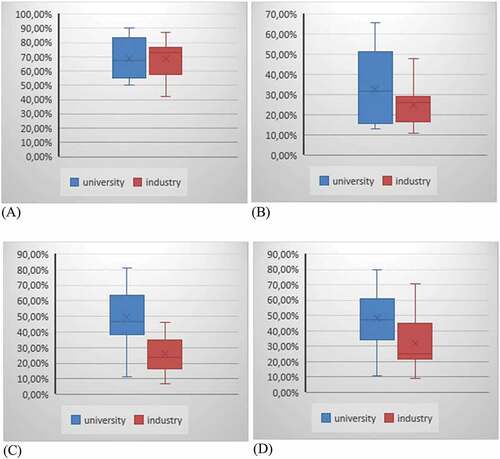
Table 2. Result of statistical test
The result of hypothesis test in Table shows that the learning purpose and experience from the university are similar with the industry as visualized by Figure respectively. It is shown by the fourth column of Table , in which the hypothesis test produces from both aspects that disable the rejection of null hypothesis. It means both university and industry share similar learning performance from the perspective of human learners in these aspects. While the result of hypothesis test from the perspective of learning outcome in term of useful knowledge and skill as presented by Figure respectively, reject the null hypothesis as shown by
in the fourth column of Table . It shows a performance difference between the university and industry to deliver the outcome of information technology learning.
Moreover, running Pearson correlation as shown by r in the sixth column of Table produce a strong positive correlation between the university and industry for the aspect of learning purpose and experience as well as for useful knowledge and skill. It means both university and industry share similar data trend of human learner activities in information technology learning. It indicates the same phenomenon is happened in both university and industry in all aspects of investigation.
5. Discussion
The higher education exhibits strong activities in learning and academic publication based on the result of policy analysis in column D of Table . These activities are enforced mainly by SNPT (Citation2020), and strengthened by the national research program and MBKM. Higher education also exhibits moderate activities in grantsmanship, industry training courses, contract research, and the creation of patent and license, that are supported by either the national research program or MBKM. These findings show that SNPT (Citation2020) obviously becomes the foundation of university innovation, and it is strengthened and extended by the national research program and MBKM to reach a wider spectrum of university entrepreneurial activities. The evaluation result also discloses the lack of policy to support the activities of consulting, spin-off firm formation, and the creation of a technology park in higher education. It is worth to note that the activity of consulting becomes the door for industrial recognition to the value of university innovation, while the last two activities, i.e., the spin-off firm formation and the creation of technology park, deliver the highest contribution to achieve knowledge society and knowledge economy.
The survey on industry readiness to deal with higher education discloses an interesting phenomenon particularly in university—industry relations as a joint agent of knowledge and skill. In term of providing learning activities, the industry presents its readiness to provide knowledge and skill through its experience mainly in technology exploration and improvisation. The industry also shows its readiness to deal with higher education that is represented by a strong knowledge capitalization in UI/UX, software development, web and mobile technology, project management, and information system. The readiness of the industry is also shown by its critique to the learning process of the university that is claimed suffering from outdated and unfocused knowledge, outdated skill, and inefficient learning processes. The critique to the university is also addressed to the problem of interaction on the university-industry cooperation due to the difficulties to develop mutual cooperation, the communication issues, the impractical operation to deal with the real industrial or business practices, the unachievable target of collaboration, and the outdated knowledge of the university.
The survey on human learner’s perspective discloses the capacity of both university and industry to serve as the agent of knowledge and skill. In term of human learner’s intention to join with a learning process, both parties obtain similar scores from eight aspects of measurement. In this case, the university slightly excel in three aspects, i.e., developing knowledge, skill, and spiritual life. While the industry excels in five aspects, i.e., to have the industrial or business experience, to build career, start-up and entrepreneurship, and to develop a professional life and network. This result shows that the university excels in developing the inner capacities of human learners. Perhaps, it is influenced by the learning environment of the university that includes vary facilities and programs for knowledge transfer, and also the commitment to provide the academic atmosphere. While the industry excels in training and developing professional life. This perspective is due to the exposure in production and business practices to any individual involved in the industry. These findings are validated by the experience of human learners in learning process, in which the university shows superior performance in knowledge development and knowledge transfer, while the industry excels to sharpen the existence of individual in entrepreneurship and professional life. Similar phenomenon on learning capacity is shown by the survey result of learning outcome. In this case, the university still performs superior in all aspect of knowledge transfer and almost all aspect of skill transfer, except for entrepreneurship and project management which the industry gains its superiority. It means the university still become the prime agent of knowledge and skill, while the industry act as the supporting agent to sharpen the entrepreneurship and project management that become the door for a professional life.
Referring to the mapping of higher education policies to the spectrum of university entrepreneurial activities, Indonesia tends to take a moderate strategy in triple helix relations by empowering the industrial training courses and research activities throughout the nation wide. While it is normal as a developing country to strengthen the quality of the graduate and to improve research outcome, the strategy shows a low confidence on innovative capacity to drive knowledge society and economy as shown by reaching only a limited scope of entrepreneurial activities. The survey however shows that the university still delivers major contribution in knowledge and skill transfer to human learner, despite their function as a joint agent with the industry to provide knowledge and skill for higher education. In this case, the contribution of university is shown by the statistical analysis of the learning outcome in term of delivering useful knowledge and skill, in which the results reject the null hypothesis. Hence, as shown by Figure respectively.
On the other hand, the industry as well as the university still receives equal trust from human learners in term of the learning purpose and learning experience as shown by the result of statistical analysis, in which it disables the rejection of null hypothesis. Hence, as shown by Figure respectively, even though most knowledge and skill transfer are delivered by the university. This phenomenon shows that the industry contribution on shaping the human learner with the industrial experience, entrepreneurship, project management, and professional development plays a significant role in information technology learning.
6. Conclusion
The blank spot in higher education policy to support the activity of consulting, spin-off firm formation and the creation of technology park needs to be solved. The commitment from the government, university and industry to strengthen the whole spectrum of university entrepreneurial activities is vital to achieve knowledge society and knowledge economy. The study discloses the contribution of university to deliver most knowledge and skill to human learner except for entrepreneurship and project management. It also reveals the potency of industry to support the firm formation by delivering a strong knowledge on entrepreneurship and project management in learning process. Therefore, the university needs to organize a tight cooperation with the industry to improve the quality of innovations that enable the industrial consultation, spin-off firm formation, and the development of a technological park. Referring to the development of Indonesia’s national innovation system that is built mainly on the basis of ministerial level (CIPG and Nesta, Citation2019; Lakitan, Citation2011; Taufik, Citation2007), the study becomes an alert to reform the national innovation system by assigning a greater role for the collaboration of university and industry to contribute on technological development. Hence, it’s time to call a more aggressive policy that drives university innovation to conduct more consultation to the industry, create more patent and licensing, deliver more start-ups, and develop the technological park. Future study shall focus on investigating the economic contribution of university entrepreneurial activities in collaboration with the industry, and their influence to the national innovation system.
Disclosure statement
No potential conflict of interest was reported by the author(s).
Additional information
Funding
References
- Abramo, G., D’Angelo, C. A., Di Costa, F., & Sollazzi, M. (2009). University–industry collaboration in Italy: A bibliometric examination. Technovation, 29(6–7), 498–17. https://doi.org/10.1016/j.technovation.2008.11.003
- ACM-IEEE. (2020). Computing curricula 2020: paradigms for global computing education. https://doi.org/10.1145/3467967
- Agrawal, A., & Henderson, R. (2002). Putting patents in context: Exploring knowledge transfer from MIT. Management Science, 48(1), 44–60. https://doi.org/10.1287/mnsc.48.1.44.14279
- Al-Shehri, A., Ebrahim, M. A., Shafeek, H., Soliman, M. F., & Abdel-Aziz, M. H. (2013). Bridging the gap between university and industry: efforts made at faculty of engineering – rabigh Saudi Arabia. International Conference on Advanced Information and Communication Technology for Education (ICAICTE 2013).
- Bercovitz, J., & Feldman, M. P. (2006). Entrepreneurial university and technology transfer: A conceptual framework for understanding knowledge-based economic development. Journal of Technology Transfer, 31(1), 175–188. https://doi.org/10.1007/s10961-005-5029-z
- Bubela, T. M., & Caulfield, T. (2010). Role and reality: Technology transfer at Canadian university. Trends in Biotechnology, 28(9), 447–451. https://doi.org/10.1016/j.tibtech.2010.06.002
- Buth, L., Bhakar, V., Sihag, N., Posselt, G., Bohme, S., Sangwan, K. S., & Hermann, C Metternich, J., Glass, R. (2017). Bridging the qualification gap between academia and industry in India. Procedia Manufacturing, 9 2017 , 275–282 . https://doi.org/10.1016/j.promfg.2017.04.009
- CIPG and Nesta. (2019). Understanding Indonesia’s innovation system. Downloaded from https://media.nesta.org.uk 25 November 2021
- DGHE. (2015). Indonesian research funding systems and infrastructure. British Council Global Education Dialogues – East Asia Series 2014-2015. Downloaded from https://www.britishcouncil.id 7 March 2022
- Etzkowitz, H., & Leydesdorff, L. (1998). The endless transition: A ”triple helix” of university-industry-government relations. Minerva, 36(3), 203–208. https://doi.org/10.1023/A:1004348123030
- Etzkowitz, H., & Leydesdorff, L. (2000). The dynamics of innovation: From national systems and “Mode 2” to a triple helix of university-industry-government relations. Research Policy, 29(2), 109–123. https://doi.org/10.1016/S0048-7333(99)00055-4
- Etzkowitz, H., Webster, A., Gebhardt, C., & Terra, B. (2000). The future of the university and the university of the future: Evolution of ivory tower to entrepreneurial paradigm. Research Policy, 29(2), 313–330. https://doi.org/10.1016/S0048-7333(99)00069-4
- Lakitan, B. (2011 National Innovation System in Indonesia: Present Status and Challenges). . . Presented at the Annual Meeting of Science and Technology Studies, Tokyo Institute of Technology, 10-12 June 201110-12 June 2011
- Motohashi, K., & Muramatsu, S. (2012). Examining the university industry collaboration policy in Japan: Patent analysis. Technology in Society 34 2 149–162 doi:https://doi.org/10.1016/j.techsoc.2012.02.006, .
- Pabbajah, M., Abdullah, I., Widyanti, R. N., Jubba, H., & Alim, N. (2020). Student demoralization in education:The industrialization of university curriculum in 4.0 Era Indonesia. Cogent Education, 7(1), 1779506. https://doi.org/10.1080/2331186X.2020.1779506
- Petruzzelli, A. M. (2011). The impact of technological relatedness, prior ties, and geographical distance on university-industry collaborations: A joint-patent analysis. Technovation, 31(7), 309–319. https://doi.org/10.1016/j.technovation.2011.01.008
- Philpott, K., Dooley, L., O’Reilly, C., & Lupton, G. (2011). The entrepreneurial university: Examining the underlying academic tensions. Technovation, 31(4), 161–170. https://doi.org/10.1016/j.technovation.2010.12.003
- Povoa, L. M. C., & Rapini, M. S. (2010). Technology transfer from university and public research institutes to firms in Brazil: What is transferred and how the transfer is carried out. Science and Public Policy, 37(2), 147–159. https://doi.org/10.3152/030234210X496619
- Sartika, D. (2020 Accessed 1 12 2021). Essay: liberating learning in Indonesian higher education. Inside Indonesia, . October-December 2020. Downloaded from https://www.insideindonesia.org
- SNPT. (2020 The National Standard on Higher Education (Standar Nasional Pendidikan Tinggi) 3 (Indonesia Ministry of Education and Culture (Kementerian Pendidikan dan Kebudayaan))Accessed 1 12 2021). . , (). https://peraturan.bpk.go.id/Home/Details/163703/permendikbud-no-3-tahun-2020 BERITA NEGARA REPUBLIK INDONESIA No.47, 2020, 1-75
- Taufik, T. A. (2007). Indonesia’s sub-national innovation system policy and programmes. National workshop on subnational innovation systems and technology capacity building policies to enhance competitiveness of SMEs, 1–21 Accessed1 December 2007 2021, 3-4 April 2007 (BPPT (Agency for the Assessment and Application of Technology – Indonesia)) Jakarta, Indonesia.
- Vaaland, T. I., & Ishengoma, E. (2016). University-industry linkages in developing countries: Perceived effect on innovation. Education + Training, 58(9), 1014–1040. https://doi.org/10.1108/ET-07-2015-0067
- Wallin, J., Isaksson, O., Larsson, A., & Elfstrom, B. (2014). Bridging the gap between university and industry: Three mechanisms for innovation efficiency. International Journal of Innovation and Technology Management, 11(1), 1440005. https://doi.org/10.1142/S0219877014400057




